(PDF) The Importance of Early Childhood Education
VerifiedAdded on 2021/02/19
|12
|3469
|110
AI Summary
Contribute Materials
Your contribution can guide someone’s learning journey. Share your
documents today.
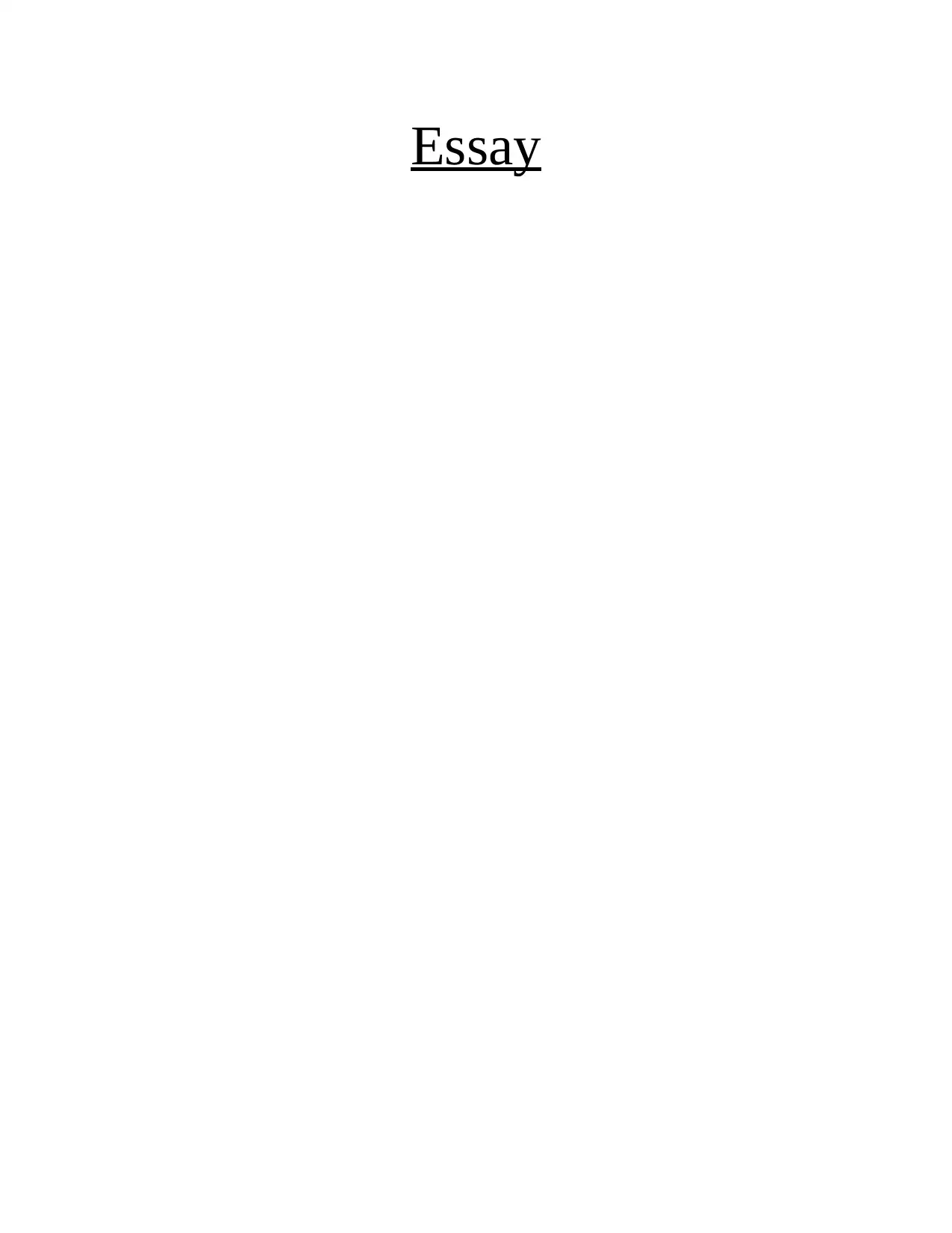
Essay
Secure Best Marks with AI Grader
Need help grading? Try our AI Grader for instant feedback on your assignments.
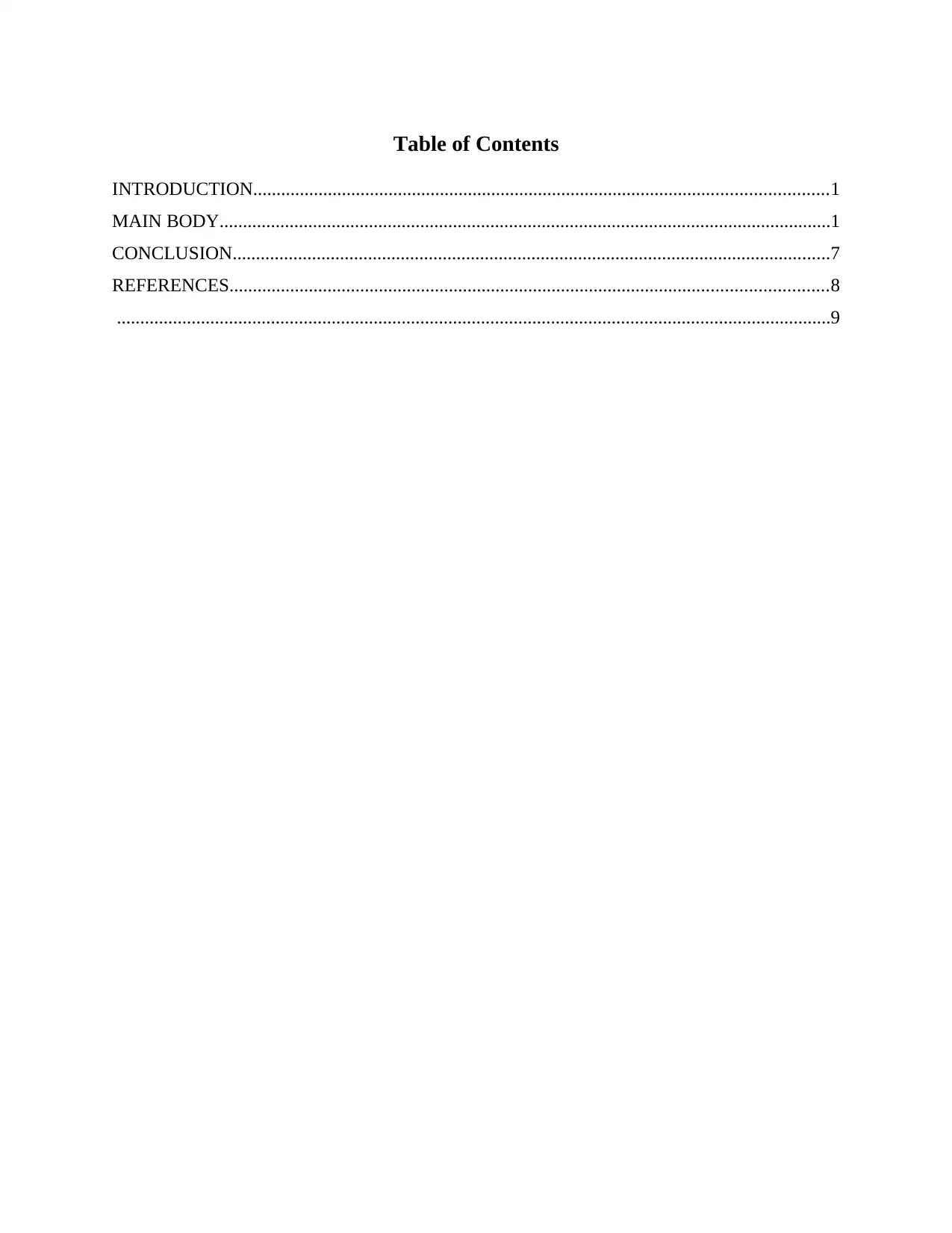
Table of Contents
INTRODUCTION...........................................................................................................................1
MAIN BODY...................................................................................................................................1
CONCLUSION................................................................................................................................7
REFERENCES................................................................................................................................8
.........................................................................................................................................................9
INTRODUCTION...........................................................................................................................1
MAIN BODY...................................................................................................................................1
CONCLUSION................................................................................................................................7
REFERENCES................................................................................................................................8
.........................................................................................................................................................9
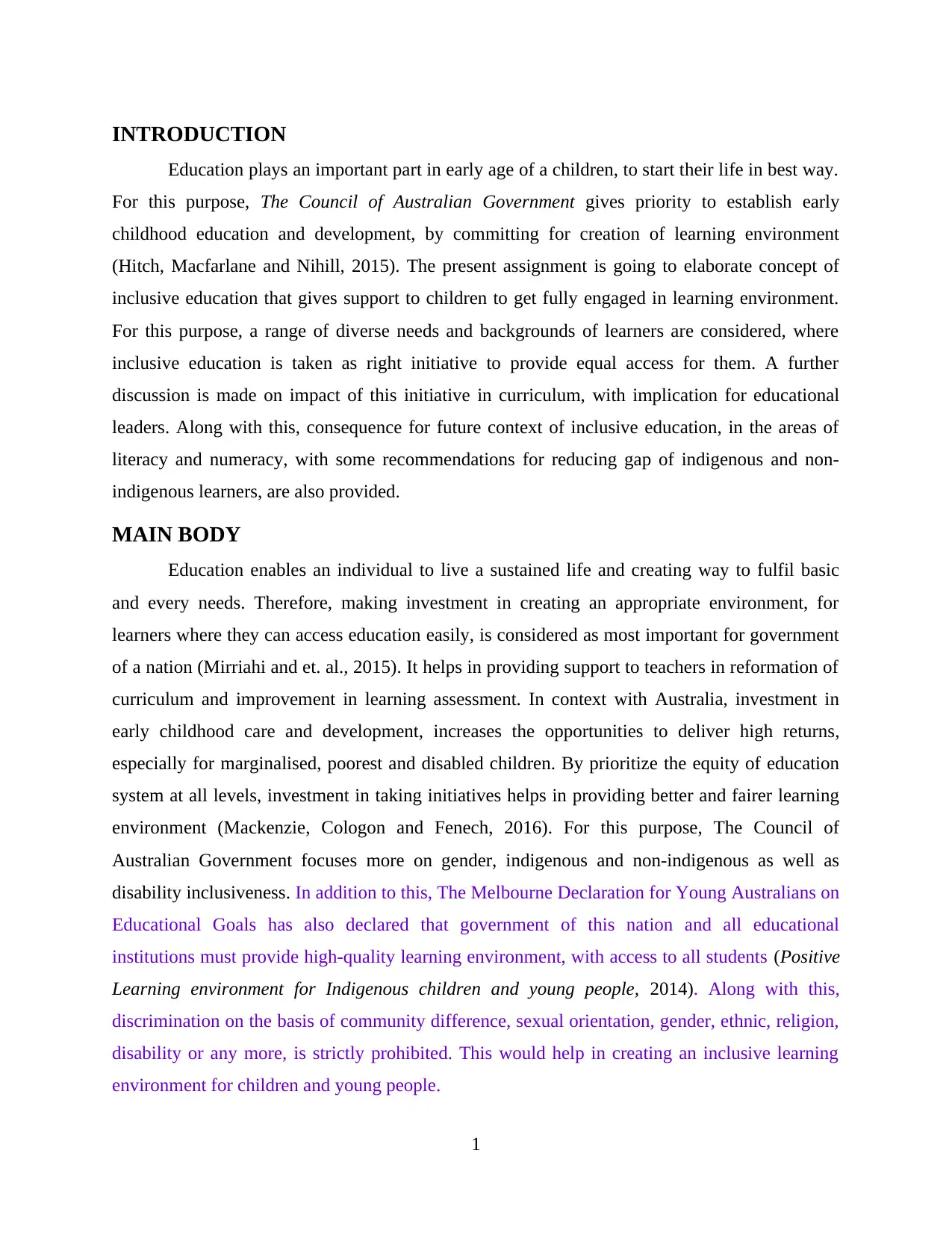
INTRODUCTION
Education plays an important part in early age of a children, to start their life in best way.
For this purpose, The Council of Australian Government gives priority to establish early
childhood education and development, by committing for creation of learning environment
(Hitch, Macfarlane and Nihill, 2015). The present assignment is going to elaborate concept of
inclusive education that gives support to children to get fully engaged in learning environment.
For this purpose, a range of diverse needs and backgrounds of learners are considered, where
inclusive education is taken as right initiative to provide equal access for them. A further
discussion is made on impact of this initiative in curriculum, with implication for educational
leaders. Along with this, consequence for future context of inclusive education, in the areas of
literacy and numeracy, with some recommendations for reducing gap of indigenous and non-
indigenous learners, are also provided.
MAIN BODY
Education enables an individual to live a sustained life and creating way to fulfil basic
and every needs. Therefore, making investment in creating an appropriate environment, for
learners where they can access education easily, is considered as most important for government
of a nation (Mirriahi and et. al., 2015). It helps in providing support to teachers in reformation of
curriculum and improvement in learning assessment. In context with Australia, investment in
early childhood care and development, increases the opportunities to deliver high returns,
especially for marginalised, poorest and disabled children. By prioritize the equity of education
system at all levels, investment in taking initiatives helps in providing better and fairer learning
environment (Mackenzie, Cologon and Fenech, 2016). For this purpose, The Council of
Australian Government focuses more on gender, indigenous and non-indigenous as well as
disability inclusiveness. In addition to this, The Melbourne Declaration for Young Australians on
Educational Goals has also declared that government of this nation and all educational
institutions must provide high-quality learning environment, with access to all students (Positive
Learning environment for Indigenous children and young people, 2014). Along with this,
discrimination on the basis of community difference, sexual orientation, gender, ethnic, religion,
disability or any more, is strictly prohibited. This would help in creating an inclusive learning
environment for children and young people.
1
Education plays an important part in early age of a children, to start their life in best way.
For this purpose, The Council of Australian Government gives priority to establish early
childhood education and development, by committing for creation of learning environment
(Hitch, Macfarlane and Nihill, 2015). The present assignment is going to elaborate concept of
inclusive education that gives support to children to get fully engaged in learning environment.
For this purpose, a range of diverse needs and backgrounds of learners are considered, where
inclusive education is taken as right initiative to provide equal access for them. A further
discussion is made on impact of this initiative in curriculum, with implication for educational
leaders. Along with this, consequence for future context of inclusive education, in the areas of
literacy and numeracy, with some recommendations for reducing gap of indigenous and non-
indigenous learners, are also provided.
MAIN BODY
Education enables an individual to live a sustained life and creating way to fulfil basic
and every needs. Therefore, making investment in creating an appropriate environment, for
learners where they can access education easily, is considered as most important for government
of a nation (Mirriahi and et. al., 2015). It helps in providing support to teachers in reformation of
curriculum and improvement in learning assessment. In context with Australia, investment in
early childhood care and development, increases the opportunities to deliver high returns,
especially for marginalised, poorest and disabled children. By prioritize the equity of education
system at all levels, investment in taking initiatives helps in providing better and fairer learning
environment (Mackenzie, Cologon and Fenech, 2016). For this purpose, The Council of
Australian Government focuses more on gender, indigenous and non-indigenous as well as
disability inclusiveness. In addition to this, The Melbourne Declaration for Young Australians on
Educational Goals has also declared that government of this nation and all educational
institutions must provide high-quality learning environment, with access to all students (Positive
Learning environment for Indigenous children and young people, 2014). Along with this,
discrimination on the basis of community difference, sexual orientation, gender, ethnic, religion,
disability or any more, is strictly prohibited. This would help in creating an inclusive learning
environment for children and young people.
1
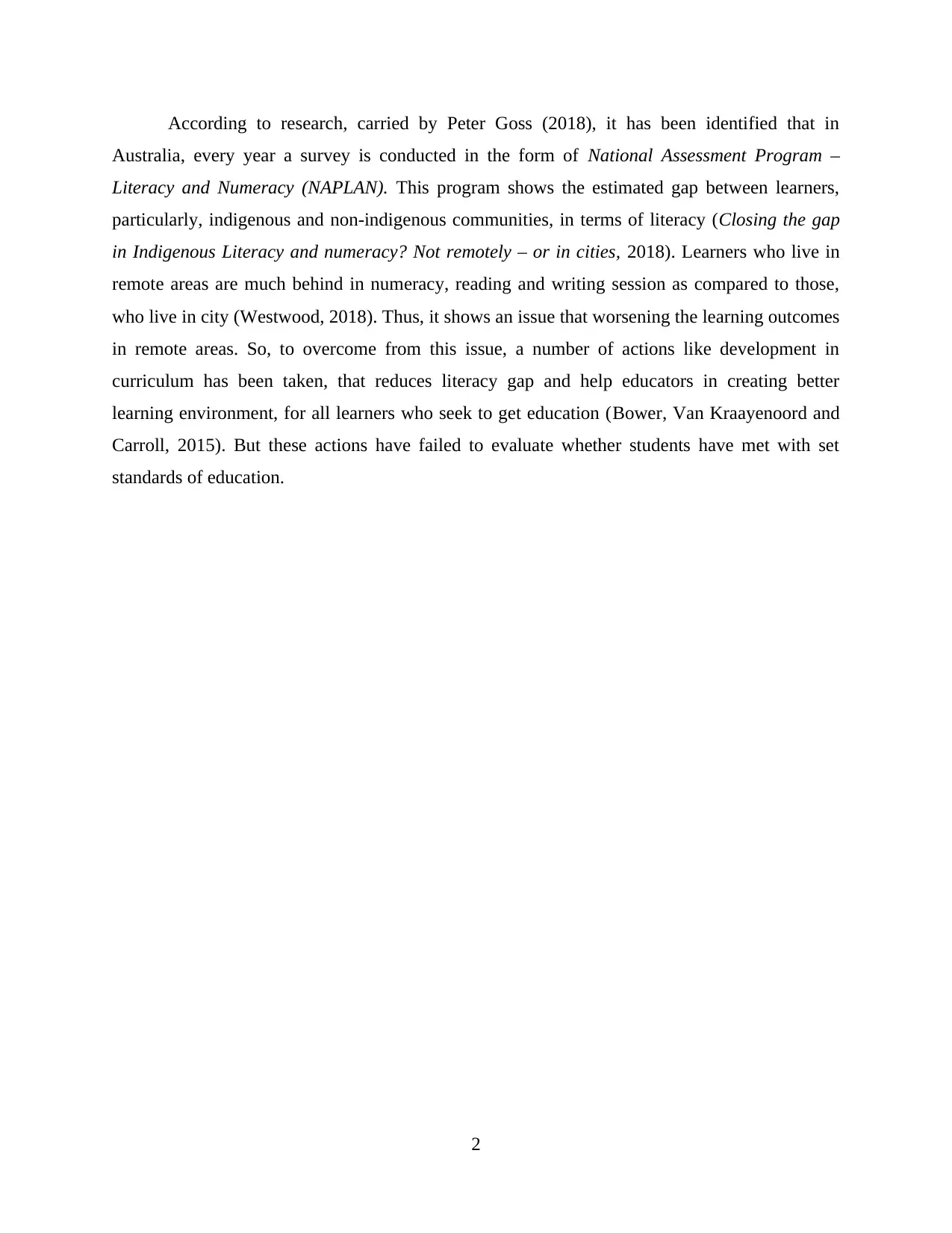
According to research, carried by Peter Goss (2018), it has been identified that in
Australia, every year a survey is conducted in the form of National Assessment Program –
Literacy and Numeracy (NAPLAN). This program shows the estimated gap between learners,
particularly, indigenous and non-indigenous communities, in terms of literacy (Closing the gap
in Indigenous Literacy and numeracy? Not remotely – or in cities, 2018). Learners who live in
remote areas are much behind in numeracy, reading and writing session as compared to those,
who live in city (Westwood, 2018). Thus, it shows an issue that worsening the learning outcomes
in remote areas. So, to overcome from this issue, a number of actions like development in
curriculum has been taken, that reduces literacy gap and help educators in creating better
learning environment, for all learners who seek to get education (Bower, Van Kraayenoord and
Carroll, 2015). But these actions have failed to evaluate whether students have met with set
standards of education.
2
Australia, every year a survey is conducted in the form of National Assessment Program –
Literacy and Numeracy (NAPLAN). This program shows the estimated gap between learners,
particularly, indigenous and non-indigenous communities, in terms of literacy (Closing the gap
in Indigenous Literacy and numeracy? Not remotely – or in cities, 2018). Learners who live in
remote areas are much behind in numeracy, reading and writing session as compared to those,
who live in city (Westwood, 2018). Thus, it shows an issue that worsening the learning outcomes
in remote areas. So, to overcome from this issue, a number of actions like development in
curriculum has been taken, that reduces literacy gap and help educators in creating better
learning environment, for all learners who seek to get education (Bower, Van Kraayenoord and
Carroll, 2015). But these actions have failed to evaluate whether students have met with set
standards of education.
2
Secure Best Marks with AI Grader
Need help grading? Try our AI Grader for instant feedback on your assignments.
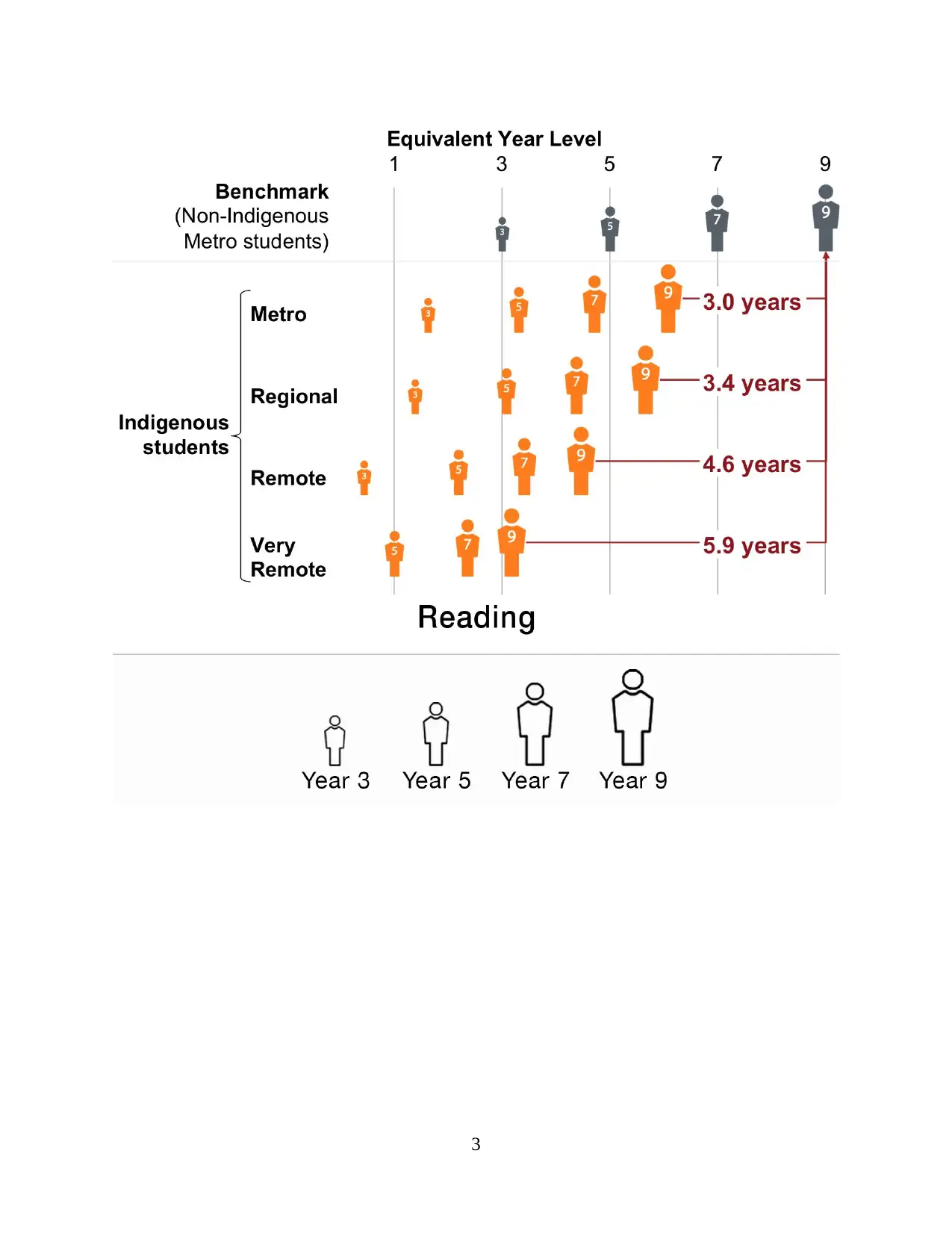
3
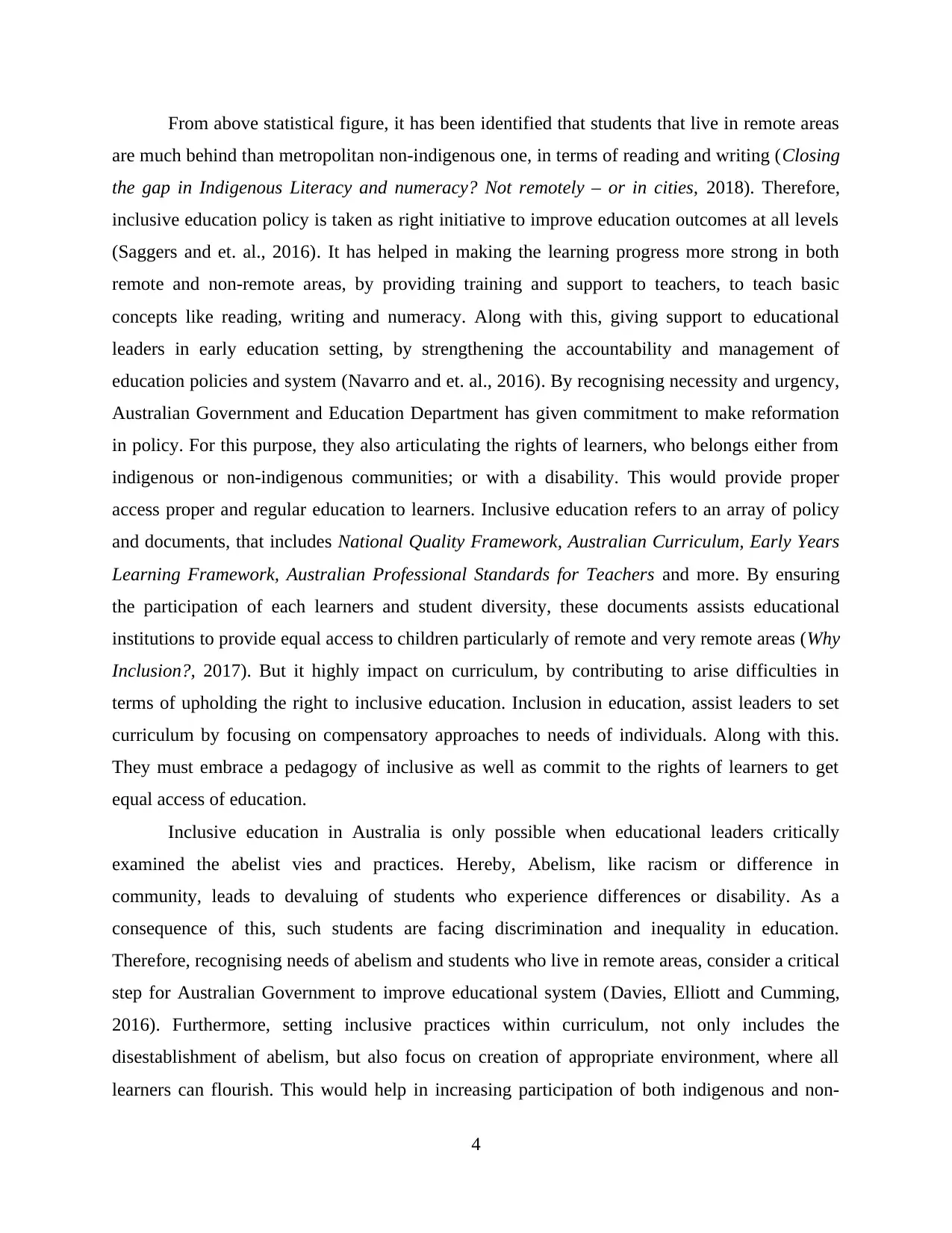
From above statistical figure, it has been identified that students that live in remote areas
are much behind than metropolitan non-indigenous one, in terms of reading and writing (Closing
the gap in Indigenous Literacy and numeracy? Not remotely – or in cities, 2018). Therefore,
inclusive education policy is taken as right initiative to improve education outcomes at all levels
(Saggers and et. al., 2016). It has helped in making the learning progress more strong in both
remote and non-remote areas, by providing training and support to teachers, to teach basic
concepts like reading, writing and numeracy. Along with this, giving support to educational
leaders in early education setting, by strengthening the accountability and management of
education policies and system (Navarro and et. al., 2016). By recognising necessity and urgency,
Australian Government and Education Department has given commitment to make reformation
in policy. For this purpose, they also articulating the rights of learners, who belongs either from
indigenous or non-indigenous communities; or with a disability. This would provide proper
access proper and regular education to learners. Inclusive education refers to an array of policy
and documents, that includes National Quality Framework, Australian Curriculum, Early Years
Learning Framework, Australian Professional Standards for Teachers and more. By ensuring
the participation of each learners and student diversity, these documents assists educational
institutions to provide equal access to children particularly of remote and very remote areas (Why
Inclusion?, 2017). But it highly impact on curriculum, by contributing to arise difficulties in
terms of upholding the right to inclusive education. Inclusion in education, assist leaders to set
curriculum by focusing on compensatory approaches to needs of individuals. Along with this.
They must embrace a pedagogy of inclusive as well as commit to the rights of learners to get
equal access of education.
Inclusive education in Australia is only possible when educational leaders critically
examined the abelist vies and practices. Hereby, Abelism, like racism or difference in
community, leads to devaluing of students who experience differences or disability. As a
consequence of this, such students are facing discrimination and inequality in education.
Therefore, recognising needs of abelism and students who live in remote areas, consider a critical
step for Australian Government to improve educational system (Davies, Elliott and Cumming,
2016). Furthermore, setting inclusive practices within curriculum, not only includes the
disestablishment of abelism, but also focus on creation of appropriate environment, where all
learners can flourish. This would help in increasing participation of both indigenous and non-
4
are much behind than metropolitan non-indigenous one, in terms of reading and writing (Closing
the gap in Indigenous Literacy and numeracy? Not remotely – or in cities, 2018). Therefore,
inclusive education policy is taken as right initiative to improve education outcomes at all levels
(Saggers and et. al., 2016). It has helped in making the learning progress more strong in both
remote and non-remote areas, by providing training and support to teachers, to teach basic
concepts like reading, writing and numeracy. Along with this, giving support to educational
leaders in early education setting, by strengthening the accountability and management of
education policies and system (Navarro and et. al., 2016). By recognising necessity and urgency,
Australian Government and Education Department has given commitment to make reformation
in policy. For this purpose, they also articulating the rights of learners, who belongs either from
indigenous or non-indigenous communities; or with a disability. This would provide proper
access proper and regular education to learners. Inclusive education refers to an array of policy
and documents, that includes National Quality Framework, Australian Curriculum, Early Years
Learning Framework, Australian Professional Standards for Teachers and more. By ensuring
the participation of each learners and student diversity, these documents assists educational
institutions to provide equal access to children particularly of remote and very remote areas (Why
Inclusion?, 2017). But it highly impact on curriculum, by contributing to arise difficulties in
terms of upholding the right to inclusive education. Inclusion in education, assist leaders to set
curriculum by focusing on compensatory approaches to needs of individuals. Along with this.
They must embrace a pedagogy of inclusive as well as commit to the rights of learners to get
equal access of education.
Inclusive education in Australia is only possible when educational leaders critically
examined the abelist vies and practices. Hereby, Abelism, like racism or difference in
community, leads to devaluing of students who experience differences or disability. As a
consequence of this, such students are facing discrimination and inequality in education.
Therefore, recognising needs of abelism and students who live in remote areas, consider a critical
step for Australian Government to improve educational system (Davies, Elliott and Cumming,
2016). Furthermore, setting inclusive practices within curriculum, not only includes the
disestablishment of abelism, but also focus on creation of appropriate environment, where all
learners can flourish. This would help in increasing participation of both indigenous and non-
4
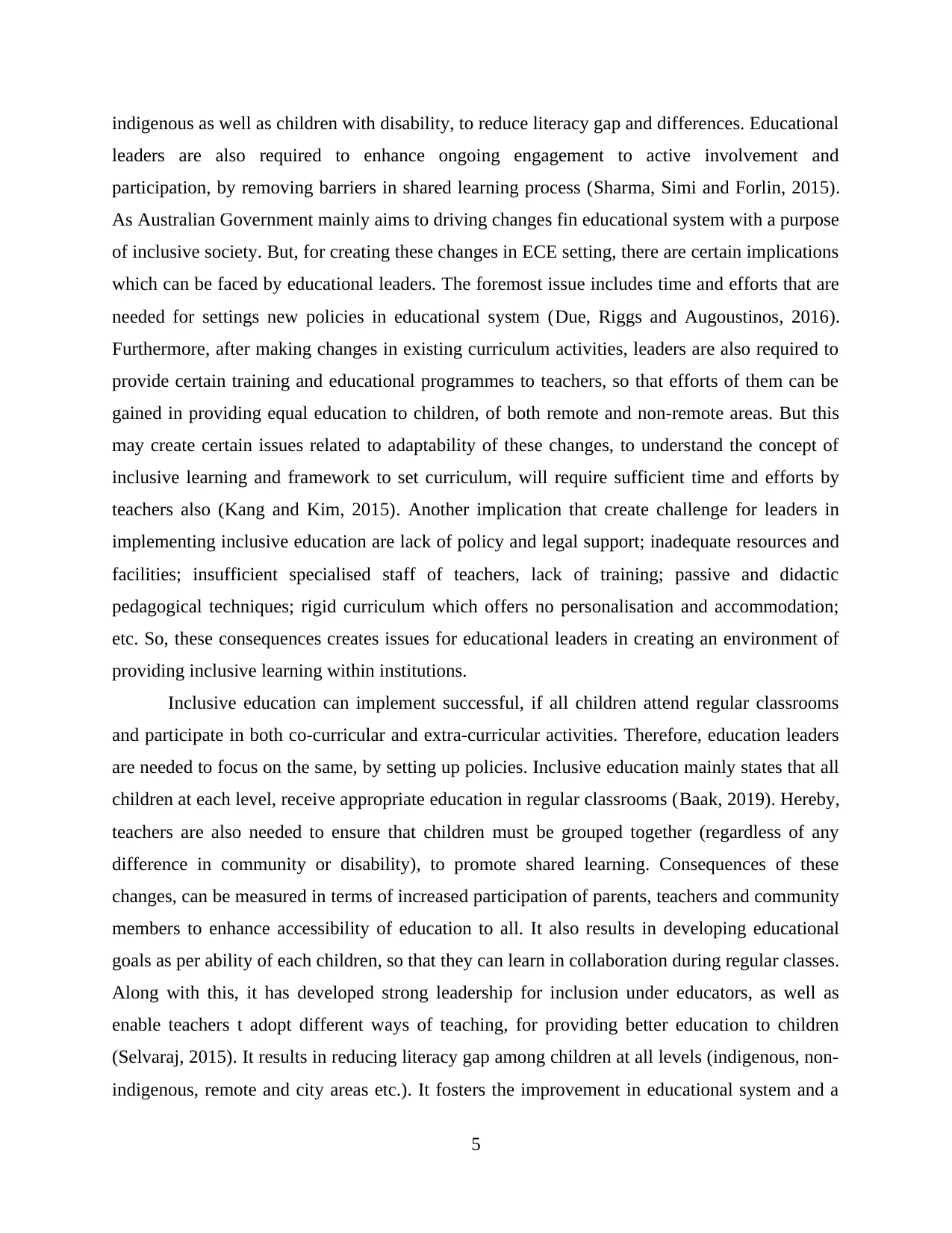
indigenous as well as children with disability, to reduce literacy gap and differences. Educational
leaders are also required to enhance ongoing engagement to active involvement and
participation, by removing barriers in shared learning process (Sharma, Simi and Forlin, 2015).
As Australian Government mainly aims to driving changes fin educational system with a purpose
of inclusive society. But, for creating these changes in ECE setting, there are certain implications
which can be faced by educational leaders. The foremost issue includes time and efforts that are
needed for settings new policies in educational system (Due, Riggs and Augoustinos, 2016).
Furthermore, after making changes in existing curriculum activities, leaders are also required to
provide certain training and educational programmes to teachers, so that efforts of them can be
gained in providing equal education to children, of both remote and non-remote areas. But this
may create certain issues related to adaptability of these changes, to understand the concept of
inclusive learning and framework to set curriculum, will require sufficient time and efforts by
teachers also (Kang and Kim, 2015). Another implication that create challenge for leaders in
implementing inclusive education are lack of policy and legal support; inadequate resources and
facilities; insufficient specialised staff of teachers, lack of training; passive and didactic
pedagogical techniques; rigid curriculum which offers no personalisation and accommodation;
etc. So, these consequences creates issues for educational leaders in creating an environment of
providing inclusive learning within institutions.
Inclusive education can implement successful, if all children attend regular classrooms
and participate in both co-curricular and extra-curricular activities. Therefore, education leaders
are needed to focus on the same, by setting up policies. Inclusive education mainly states that all
children at each level, receive appropriate education in regular classrooms (Baak, 2019). Hereby,
teachers are also needed to ensure that children must be grouped together (regardless of any
difference in community or disability), to promote shared learning. Consequences of these
changes, can be measured in terms of increased participation of parents, teachers and community
members to enhance accessibility of education to all. It also results in developing educational
goals as per ability of each children, so that they can learn in collaboration during regular classes.
Along with this, it has developed strong leadership for inclusion under educators, as well as
enable teachers t adopt different ways of teaching, for providing better education to children
(Selvaraj, 2015). It results in reducing literacy gap among children at all levels (indigenous, non-
indigenous, remote and city areas etc.). It fosters the improvement in educational system and a
5
leaders are also required to enhance ongoing engagement to active involvement and
participation, by removing barriers in shared learning process (Sharma, Simi and Forlin, 2015).
As Australian Government mainly aims to driving changes fin educational system with a purpose
of inclusive society. But, for creating these changes in ECE setting, there are certain implications
which can be faced by educational leaders. The foremost issue includes time and efforts that are
needed for settings new policies in educational system (Due, Riggs and Augoustinos, 2016).
Furthermore, after making changes in existing curriculum activities, leaders are also required to
provide certain training and educational programmes to teachers, so that efforts of them can be
gained in providing equal education to children, of both remote and non-remote areas. But this
may create certain issues related to adaptability of these changes, to understand the concept of
inclusive learning and framework to set curriculum, will require sufficient time and efforts by
teachers also (Kang and Kim, 2015). Another implication that create challenge for leaders in
implementing inclusive education are lack of policy and legal support; inadequate resources and
facilities; insufficient specialised staff of teachers, lack of training; passive and didactic
pedagogical techniques; rigid curriculum which offers no personalisation and accommodation;
etc. So, these consequences creates issues for educational leaders in creating an environment of
providing inclusive learning within institutions.
Inclusive education can implement successful, if all children attend regular classrooms
and participate in both co-curricular and extra-curricular activities. Therefore, education leaders
are needed to focus on the same, by setting up policies. Inclusive education mainly states that all
children at each level, receive appropriate education in regular classrooms (Baak, 2019). Hereby,
teachers are also needed to ensure that children must be grouped together (regardless of any
difference in community or disability), to promote shared learning. Consequences of these
changes, can be measured in terms of increased participation of parents, teachers and community
members to enhance accessibility of education to all. It also results in developing educational
goals as per ability of each children, so that they can learn in collaboration during regular classes.
Along with this, it has developed strong leadership for inclusion under educators, as well as
enable teachers t adopt different ways of teaching, for providing better education to children
(Selvaraj, 2015). It results in reducing literacy gap among children at all levels (indigenous, non-
indigenous, remote and city areas etc.). It fosters the improvement in educational system and a
5
Paraphrase This Document
Need a fresh take? Get an instant paraphrase of this document with our AI Paraphraser
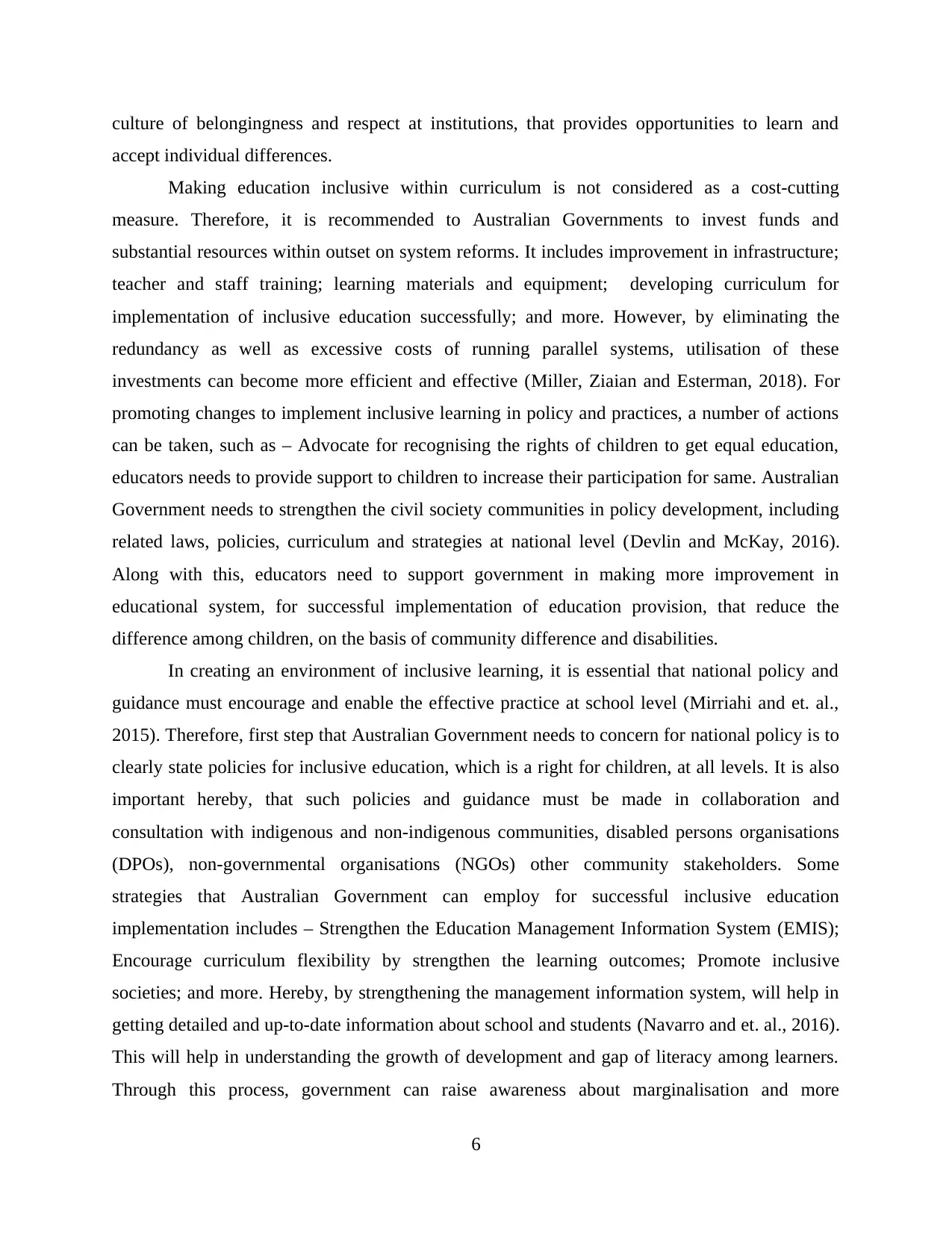
culture of belongingness and respect at institutions, that provides opportunities to learn and
accept individual differences.
Making education inclusive within curriculum is not considered as a cost-cutting
measure. Therefore, it is recommended to Australian Governments to invest funds and
substantial resources within outset on system reforms. It includes improvement in infrastructure;
teacher and staff training; learning materials and equipment; developing curriculum for
implementation of inclusive education successfully; and more. However, by eliminating the
redundancy as well as excessive costs of running parallel systems, utilisation of these
investments can become more efficient and effective (Miller, Ziaian and Esterman, 2018). For
promoting changes to implement inclusive learning in policy and practices, a number of actions
can be taken, such as – Advocate for recognising the rights of children to get equal education,
educators needs to provide support to children to increase their participation for same. Australian
Government needs to strengthen the civil society communities in policy development, including
related laws, policies, curriculum and strategies at national level (Devlin and McKay, 2016).
Along with this, educators need to support government in making more improvement in
educational system, for successful implementation of education provision, that reduce the
difference among children, on the basis of community difference and disabilities.
In creating an environment of inclusive learning, it is essential that national policy and
guidance must encourage and enable the effective practice at school level (Mirriahi and et. al.,
2015). Therefore, first step that Australian Government needs to concern for national policy is to
clearly state policies for inclusive education, which is a right for children, at all levels. It is also
important hereby, that such policies and guidance must be made in collaboration and
consultation with indigenous and non-indigenous communities, disabled persons organisations
(DPOs), non-governmental organisations (NGOs) other community stakeholders. Some
strategies that Australian Government can employ for successful inclusive education
implementation includes – Strengthen the Education Management Information System (EMIS);
Encourage curriculum flexibility by strengthen the learning outcomes; Promote inclusive
societies; and more. Hereby, by strengthening the management information system, will help in
getting detailed and up-to-date information about school and students (Navarro and et. al., 2016).
This will help in understanding the growth of development and gap of literacy among learners.
Through this process, government can raise awareness about marginalisation and more
6
accept individual differences.
Making education inclusive within curriculum is not considered as a cost-cutting
measure. Therefore, it is recommended to Australian Governments to invest funds and
substantial resources within outset on system reforms. It includes improvement in infrastructure;
teacher and staff training; learning materials and equipment; developing curriculum for
implementation of inclusive education successfully; and more. However, by eliminating the
redundancy as well as excessive costs of running parallel systems, utilisation of these
investments can become more efficient and effective (Miller, Ziaian and Esterman, 2018). For
promoting changes to implement inclusive learning in policy and practices, a number of actions
can be taken, such as – Advocate for recognising the rights of children to get equal education,
educators needs to provide support to children to increase their participation for same. Australian
Government needs to strengthen the civil society communities in policy development, including
related laws, policies, curriculum and strategies at national level (Devlin and McKay, 2016).
Along with this, educators need to support government in making more improvement in
educational system, for successful implementation of education provision, that reduce the
difference among children, on the basis of community difference and disabilities.
In creating an environment of inclusive learning, it is essential that national policy and
guidance must encourage and enable the effective practice at school level (Mirriahi and et. al.,
2015). Therefore, first step that Australian Government needs to concern for national policy is to
clearly state policies for inclusive education, which is a right for children, at all levels. It is also
important hereby, that such policies and guidance must be made in collaboration and
consultation with indigenous and non-indigenous communities, disabled persons organisations
(DPOs), non-governmental organisations (NGOs) other community stakeholders. Some
strategies that Australian Government can employ for successful inclusive education
implementation includes – Strengthen the Education Management Information System (EMIS);
Encourage curriculum flexibility by strengthen the learning outcomes; Promote inclusive
societies; and more. Hereby, by strengthening the management information system, will help in
getting detailed and up-to-date information about school and students (Navarro and et. al., 2016).
This will help in understanding the growth of development and gap of literacy among learners.
Through this process, government can raise awareness about marginalisation and more
6
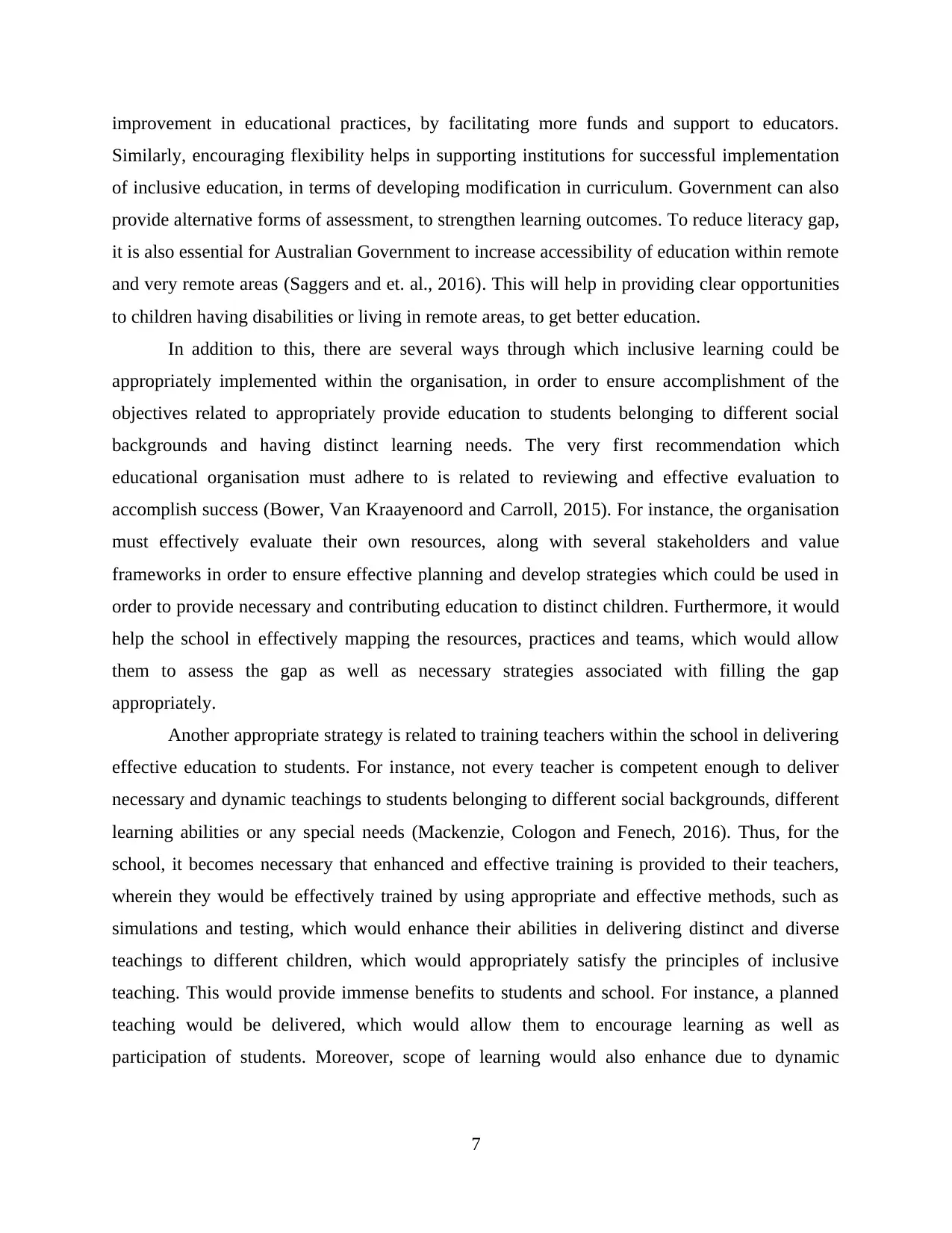
improvement in educational practices, by facilitating more funds and support to educators.
Similarly, encouraging flexibility helps in supporting institutions for successful implementation
of inclusive education, in terms of developing modification in curriculum. Government can also
provide alternative forms of assessment, to strengthen learning outcomes. To reduce literacy gap,
it is also essential for Australian Government to increase accessibility of education within remote
and very remote areas (Saggers and et. al., 2016). This will help in providing clear opportunities
to children having disabilities or living in remote areas, to get better education.
In addition to this, there are several ways through which inclusive learning could be
appropriately implemented within the organisation, in order to ensure accomplishment of the
objectives related to appropriately provide education to students belonging to different social
backgrounds and having distinct learning needs. The very first recommendation which
educational organisation must adhere to is related to reviewing and effective evaluation to
accomplish success (Bower, Van Kraayenoord and Carroll, 2015). For instance, the organisation
must effectively evaluate their own resources, along with several stakeholders and value
frameworks in order to ensure effective planning and develop strategies which could be used in
order to provide necessary and contributing education to distinct children. Furthermore, it would
help the school in effectively mapping the resources, practices and teams, which would allow
them to assess the gap as well as necessary strategies associated with filling the gap
appropriately.
Another appropriate strategy is related to training teachers within the school in delivering
effective education to students. For instance, not every teacher is competent enough to deliver
necessary and dynamic teachings to students belonging to different social backgrounds, different
learning abilities or any special needs (Mackenzie, Cologon and Fenech, 2016). Thus, for the
school, it becomes necessary that enhanced and effective training is provided to their teachers,
wherein they would be effectively trained by using appropriate and effective methods, such as
simulations and testing, which would enhance their abilities in delivering distinct and diverse
teachings to different children, which would appropriately satisfy the principles of inclusive
teaching. This would provide immense benefits to students and school. For instance, a planned
teaching would be delivered, which would allow them to encourage learning as well as
participation of students. Moreover, scope of learning would also enhance due to dynamic
7
Similarly, encouraging flexibility helps in supporting institutions for successful implementation
of inclusive education, in terms of developing modification in curriculum. Government can also
provide alternative forms of assessment, to strengthen learning outcomes. To reduce literacy gap,
it is also essential for Australian Government to increase accessibility of education within remote
and very remote areas (Saggers and et. al., 2016). This will help in providing clear opportunities
to children having disabilities or living in remote areas, to get better education.
In addition to this, there are several ways through which inclusive learning could be
appropriately implemented within the organisation, in order to ensure accomplishment of the
objectives related to appropriately provide education to students belonging to different social
backgrounds and having distinct learning needs. The very first recommendation which
educational organisation must adhere to is related to reviewing and effective evaluation to
accomplish success (Bower, Van Kraayenoord and Carroll, 2015). For instance, the organisation
must effectively evaluate their own resources, along with several stakeholders and value
frameworks in order to ensure effective planning and develop strategies which could be used in
order to provide necessary and contributing education to distinct children. Furthermore, it would
help the school in effectively mapping the resources, practices and teams, which would allow
them to assess the gap as well as necessary strategies associated with filling the gap
appropriately.
Another appropriate strategy is related to training teachers within the school in delivering
effective education to students. For instance, not every teacher is competent enough to deliver
necessary and dynamic teachings to students belonging to different social backgrounds, different
learning abilities or any special needs (Mackenzie, Cologon and Fenech, 2016). Thus, for the
school, it becomes necessary that enhanced and effective training is provided to their teachers,
wherein they would be effectively trained by using appropriate and effective methods, such as
simulations and testing, which would enhance their abilities in delivering distinct and diverse
teachings to different children, which would appropriately satisfy the principles of inclusive
teaching. This would provide immense benefits to students and school. For instance, a planned
teaching would be delivered, which would allow them to encourage learning as well as
participation of students. Moreover, scope of learning would also enhance due to dynamic
7
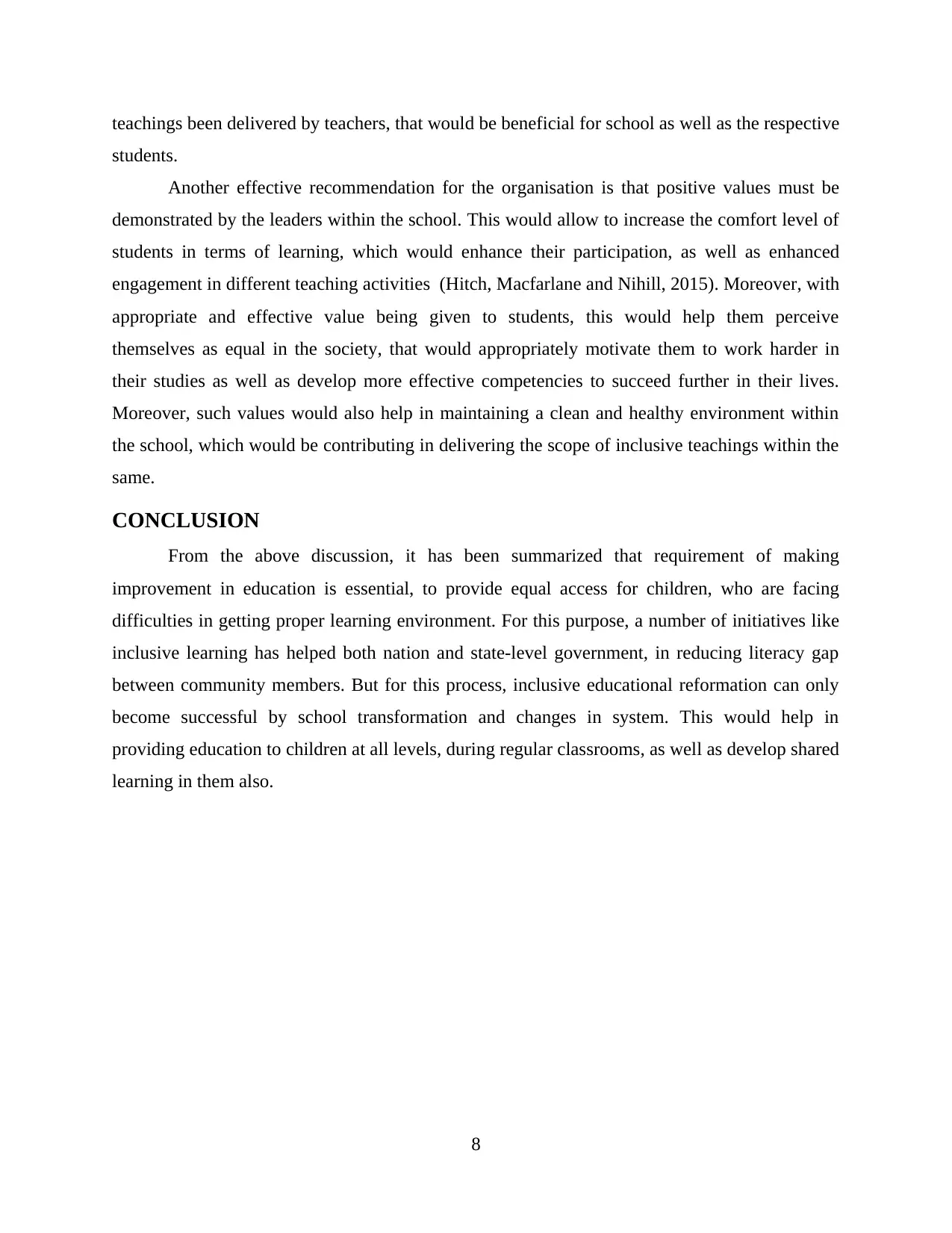
teachings been delivered by teachers, that would be beneficial for school as well as the respective
students.
Another effective recommendation for the organisation is that positive values must be
demonstrated by the leaders within the school. This would allow to increase the comfort level of
students in terms of learning, which would enhance their participation, as well as enhanced
engagement in different teaching activities (Hitch, Macfarlane and Nihill, 2015). Moreover, with
appropriate and effective value being given to students, this would help them perceive
themselves as equal in the society, that would appropriately motivate them to work harder in
their studies as well as develop more effective competencies to succeed further in their lives.
Moreover, such values would also help in maintaining a clean and healthy environment within
the school, which would be contributing in delivering the scope of inclusive teachings within the
same.
CONCLUSION
From the above discussion, it has been summarized that requirement of making
improvement in education is essential, to provide equal access for children, who are facing
difficulties in getting proper learning environment. For this purpose, a number of initiatives like
inclusive learning has helped both nation and state-level government, in reducing literacy gap
between community members. But for this process, inclusive educational reformation can only
become successful by school transformation and changes in system. This would help in
providing education to children at all levels, during regular classrooms, as well as develop shared
learning in them also.
8
students.
Another effective recommendation for the organisation is that positive values must be
demonstrated by the leaders within the school. This would allow to increase the comfort level of
students in terms of learning, which would enhance their participation, as well as enhanced
engagement in different teaching activities (Hitch, Macfarlane and Nihill, 2015). Moreover, with
appropriate and effective value being given to students, this would help them perceive
themselves as equal in the society, that would appropriately motivate them to work harder in
their studies as well as develop more effective competencies to succeed further in their lives.
Moreover, such values would also help in maintaining a clean and healthy environment within
the school, which would be contributing in delivering the scope of inclusive teachings within the
same.
CONCLUSION
From the above discussion, it has been summarized that requirement of making
improvement in education is essential, to provide equal access for children, who are facing
difficulties in getting proper learning environment. For this purpose, a number of initiatives like
inclusive learning has helped both nation and state-level government, in reducing literacy gap
between community members. But for this process, inclusive educational reformation can only
become successful by school transformation and changes in system. This would help in
providing education to children at all levels, during regular classrooms, as well as develop shared
learning in them also.
8
Secure Best Marks with AI Grader
Need help grading? Try our AI Grader for instant feedback on your assignments.
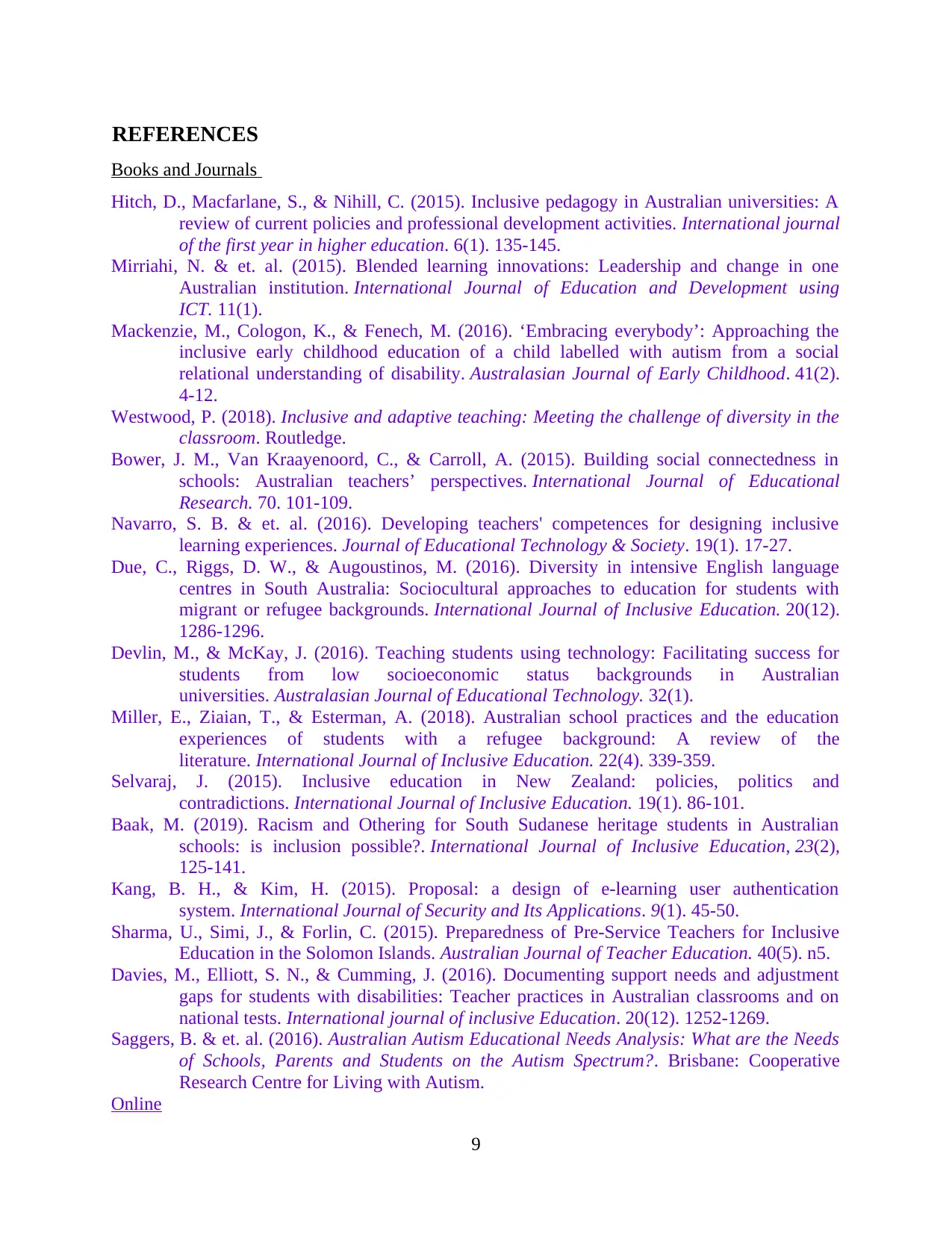
REFERENCES
Books and Journals
Hitch, D., Macfarlane, S., & Nihill, C. (2015). Inclusive pedagogy in Australian universities: A
review of current policies and professional development activities. International journal
of the first year in higher education. 6(1). 135-145.
Mirriahi, N. & et. al. (2015). Blended learning innovations: Leadership and change in one
Australian institution. International Journal of Education and Development using
ICT. 11(1).
Mackenzie, M., Cologon, K., & Fenech, M. (2016). ‘Embracing everybody’: Approaching the
inclusive early childhood education of a child labelled with autism from a social
relational understanding of disability. Australasian Journal of Early Childhood. 41(2).
4-12.
Westwood, P. (2018). Inclusive and adaptive teaching: Meeting the challenge of diversity in the
classroom. Routledge.
Bower, J. M., Van Kraayenoord, C., & Carroll, A. (2015). Building social connectedness in
schools: Australian teachers’ perspectives. International Journal of Educational
Research. 70. 101-109.
Navarro, S. B. & et. al. (2016). Developing teachers' competences for designing inclusive
learning experiences. Journal of Educational Technology & Society. 19(1). 17-27.
Due, C., Riggs, D. W., & Augoustinos, M. (2016). Diversity in intensive English language
centres in South Australia: Sociocultural approaches to education for students with
migrant or refugee backgrounds. International Journal of Inclusive Education. 20(12).
1286-1296.
Devlin, M., & McKay, J. (2016). Teaching students using technology: Facilitating success for
students from low socioeconomic status backgrounds in Australian
universities. Australasian Journal of Educational Technology. 32(1).
Miller, E., Ziaian, T., & Esterman, A. (2018). Australian school practices and the education
experiences of students with a refugee background: A review of the
literature. International Journal of Inclusive Education. 22(4). 339-359.
Selvaraj, J. (2015). Inclusive education in New Zealand: policies, politics and
contradictions. International Journal of Inclusive Education. 19(1). 86-101.
Baak, M. (2019). Racism and Othering for South Sudanese heritage students in Australian
schools: is inclusion possible?. International Journal of Inclusive Education, 23(2),
125-141.
Kang, B. H., & Kim, H. (2015). Proposal: a design of e-learning user authentication
system. International Journal of Security and Its Applications. 9(1). 45-50.
Sharma, U., Simi, J., & Forlin, C. (2015). Preparedness of Pre-Service Teachers for Inclusive
Education in the Solomon Islands. Australian Journal of Teacher Education. 40(5). n5.
Davies, M., Elliott, S. N., & Cumming, J. (2016). Documenting support needs and adjustment
gaps for students with disabilities: Teacher practices in Australian classrooms and on
national tests. International journal of inclusive Education. 20(12). 1252-1269.
Saggers, B. & et. al. (2016). Australian Autism Educational Needs Analysis: What are the Needs
of Schools, Parents and Students on the Autism Spectrum?. Brisbane: Cooperative
Research Centre for Living with Autism.
Online
9
Books and Journals
Hitch, D., Macfarlane, S., & Nihill, C. (2015). Inclusive pedagogy in Australian universities: A
review of current policies and professional development activities. International journal
of the first year in higher education. 6(1). 135-145.
Mirriahi, N. & et. al. (2015). Blended learning innovations: Leadership and change in one
Australian institution. International Journal of Education and Development using
ICT. 11(1).
Mackenzie, M., Cologon, K., & Fenech, M. (2016). ‘Embracing everybody’: Approaching the
inclusive early childhood education of a child labelled with autism from a social
relational understanding of disability. Australasian Journal of Early Childhood. 41(2).
4-12.
Westwood, P. (2018). Inclusive and adaptive teaching: Meeting the challenge of diversity in the
classroom. Routledge.
Bower, J. M., Van Kraayenoord, C., & Carroll, A. (2015). Building social connectedness in
schools: Australian teachers’ perspectives. International Journal of Educational
Research. 70. 101-109.
Navarro, S. B. & et. al. (2016). Developing teachers' competences for designing inclusive
learning experiences. Journal of Educational Technology & Society. 19(1). 17-27.
Due, C., Riggs, D. W., & Augoustinos, M. (2016). Diversity in intensive English language
centres in South Australia: Sociocultural approaches to education for students with
migrant or refugee backgrounds. International Journal of Inclusive Education. 20(12).
1286-1296.
Devlin, M., & McKay, J. (2016). Teaching students using technology: Facilitating success for
students from low socioeconomic status backgrounds in Australian
universities. Australasian Journal of Educational Technology. 32(1).
Miller, E., Ziaian, T., & Esterman, A. (2018). Australian school practices and the education
experiences of students with a refugee background: A review of the
literature. International Journal of Inclusive Education. 22(4). 339-359.
Selvaraj, J. (2015). Inclusive education in New Zealand: policies, politics and
contradictions. International Journal of Inclusive Education. 19(1). 86-101.
Baak, M. (2019). Racism and Othering for South Sudanese heritage students in Australian
schools: is inclusion possible?. International Journal of Inclusive Education, 23(2),
125-141.
Kang, B. H., & Kim, H. (2015). Proposal: a design of e-learning user authentication
system. International Journal of Security and Its Applications. 9(1). 45-50.
Sharma, U., Simi, J., & Forlin, C. (2015). Preparedness of Pre-Service Teachers for Inclusive
Education in the Solomon Islands. Australian Journal of Teacher Education. 40(5). n5.
Davies, M., Elliott, S. N., & Cumming, J. (2016). Documenting support needs and adjustment
gaps for students with disabilities: Teacher practices in Australian classrooms and on
national tests. International journal of inclusive Education. 20(12). 1252-1269.
Saggers, B. & et. al. (2016). Australian Autism Educational Needs Analysis: What are the Needs
of Schools, Parents and Students on the Autism Spectrum?. Brisbane: Cooperative
Research Centre for Living with Autism.
Online
9
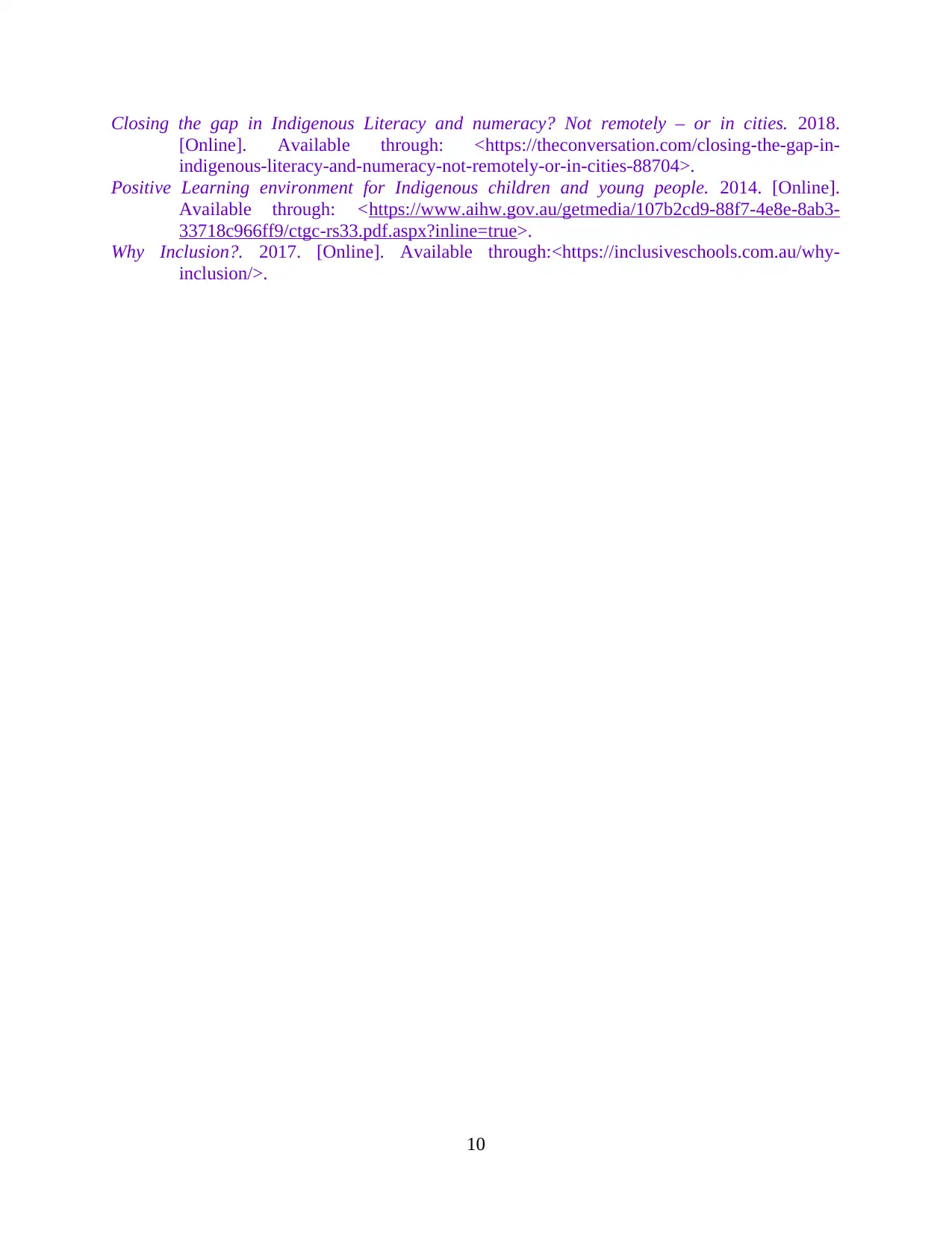
Closing the gap in Indigenous Literacy and numeracy? Not remotely – or in cities. 2018.
[Online]. Available through: <https://theconversation.com/closing-the-gap-in-
indigenous-literacy-and-numeracy-not-remotely-or-in-cities-88704>.
Positive Learning environment for Indigenous children and young people. 2014. [Online].
Available through: <https://www.aihw.gov.au/getmedia/107b2cd9-88f7-4e8e-8ab3-
33718c966ff9/ctgc-rs33.pdf.aspx?inline=true>.
Why Inclusion?. 2017. [Online]. Available through:<https://inclusiveschools.com.au/why-
inclusion/>.
10
[Online]. Available through: <https://theconversation.com/closing-the-gap-in-
indigenous-literacy-and-numeracy-not-remotely-or-in-cities-88704>.
Positive Learning environment for Indigenous children and young people. 2014. [Online].
Available through: <https://www.aihw.gov.au/getmedia/107b2cd9-88f7-4e8e-8ab3-
33718c966ff9/ctgc-rs33.pdf.aspx?inline=true>.
Why Inclusion?. 2017. [Online]. Available through:<https://inclusiveschools.com.au/why-
inclusion/>.
10
1 out of 12
Related Documents
Your All-in-One AI-Powered Toolkit for Academic Success.
+13062052269
info@desklib.com
Available 24*7 on WhatsApp / Email
![[object Object]](/_next/static/media/star-bottom.7253800d.svg)
Unlock your academic potential
© 2024 | Zucol Services PVT LTD | All rights reserved.





